Menus
- ZX-10R, YZF-R1 and S 1000 RR
- Please do the same in future in series production
- Yamaha YZF-R1 from Dominik Klein
- “Take care, buddy, I’m poisonous”!
- Similar to a Cup R6, but with a monstrous performance
- What about the lap times??
- Wilbers’ BMW S 1000 RR starts in the IDM Superbike
- According to Arne Tode, there are two types of drivers
- Curtain up for the BMW S 1000 RR from Touratech
- Chassis forgives the undulating surface in curves well
- The lap times

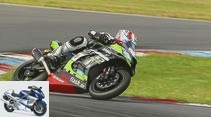
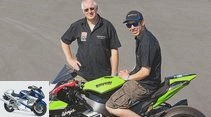
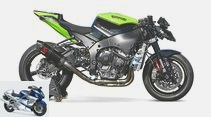

27 photos
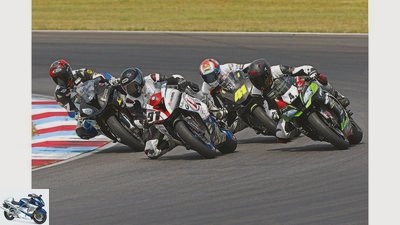
1/27
Picture gallery, TunerGP: 1000 Superbikes in comparison.
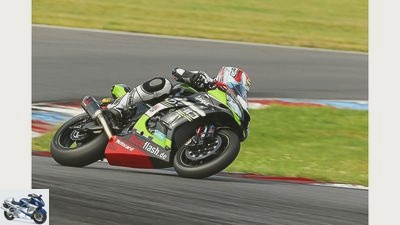
2/27
Bartschat-Kawasaki ZX-10R. Lap time: 1.43.569 min.
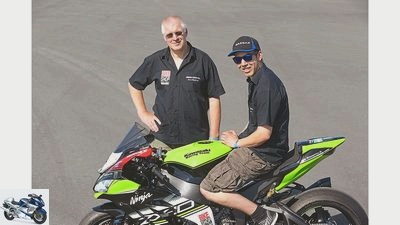
3/27
Bike shop Luchow, Bergstrasse 3, 29439 Luchow. www.bikeshop-luechow.de
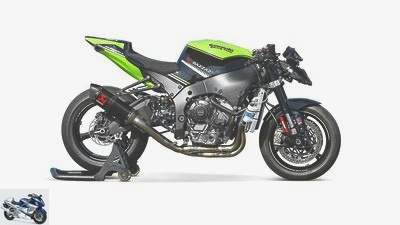
4/27
Weight 182.8 kg, front / rear 53.3 / 46.7%, output 194 hp, conversion costs approx. 12,000 euros.
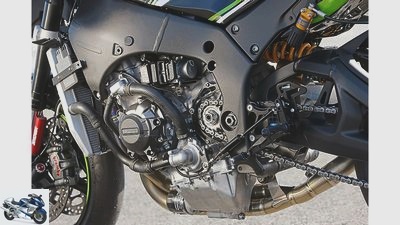
5/27
Except for the electronic removal of the gear-selective throttles, it is a completely standard engine.
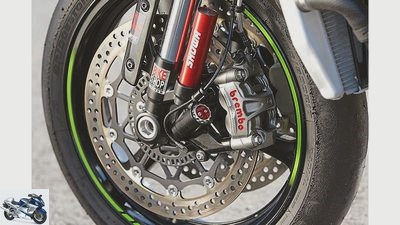
6/27
The combination of M50 monoblocks with the Brembo RCS 17 brake pump and Z04 pads works great, even with activated ABS.
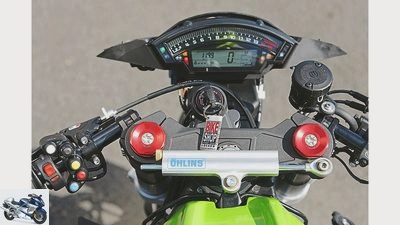
7/27
The electronic series Ohlins steering damper was replaced by a mechanical one.
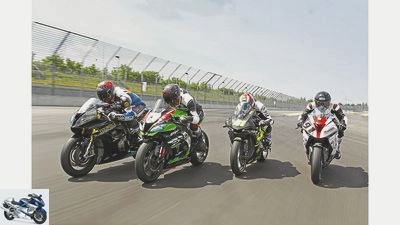
www.factstudio.de
8/27
Warmth on the racetrack: Remember guys, whoever brakes first is the washcloth!
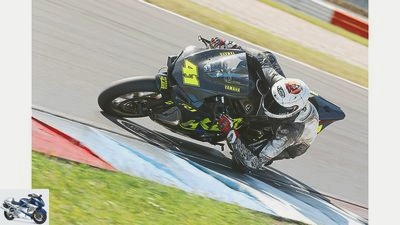
9/27
Small Yamaha YZF-R1. Lap time: 1.42.380 min.
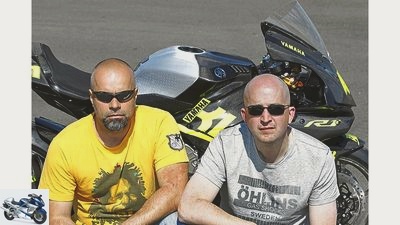
www.factstudio.de
10/27
Motorrad Klein GmbH, Rontgenstrasse 5, 66763 Dillingen / Saar. www.motorradklein.de
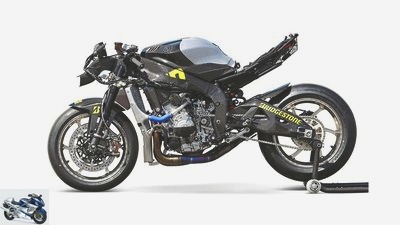
www.factstudio.de
11/27
Weight 177.3 kg, front / rear 54.4 / 45.6%, power 212 HP, conversion costs approx. 25,000 euros.
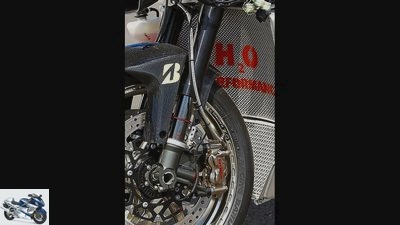
www.factstudio.de
12/27
High-end material: the front fender is made of carbon, the braking system is included by Brembo (GP4-RX saddles) and the fork comes from
K-Tech from England.
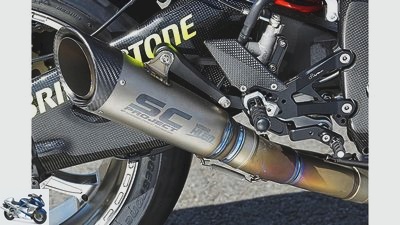
www.factstudio.de
13/27
Custom-made for Dominik’s Über-R1: complete titanium system
by SC-Project. The sound tears down the strongest walls.
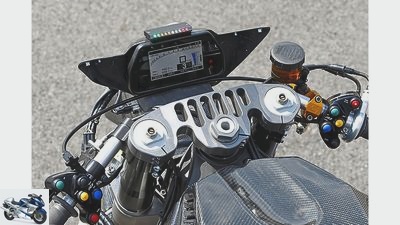
www.factstudio.de
14/27
Standard dashboard, triple clamps from IMA-Racing.
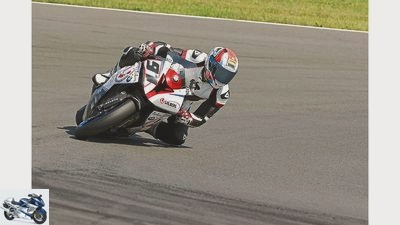
15/27
Wilbers-BMW S 1000 RR. Lap time: 1.42.780 min.
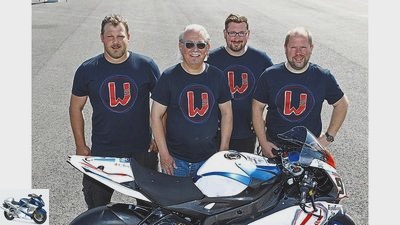
www.factstudio.de
16/27
Wilbers Triple Tuning GmbH, Alfred-Mozer-Strasse 82, 48527 Nordhorn. www.wilbers-bmw-racing.de, www.tripletuning.de
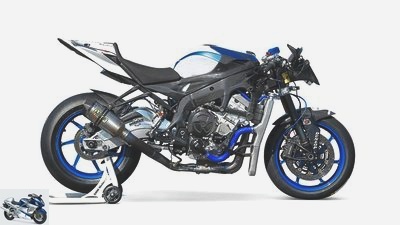
www.factstudio.de
17/27
Weight 179.9 kg, front / rear 54.0 / 46.0%, output 217 hp, conversion costs approx. 40,000 euros.
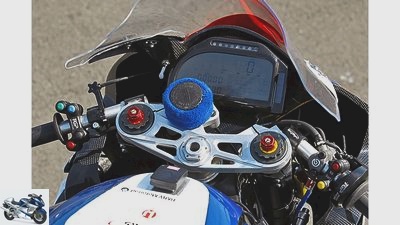
www.factstudio.de
18/27
In the middle: cleverly integrated expansion tank for the brake fluid. Like the data recording system, the dashboard comes from 2D.
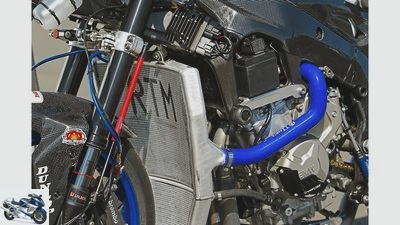
www.factstudio.de
19/27
According to the IDM regulations, little mechanical changes may be made; proper engine tuning is important.
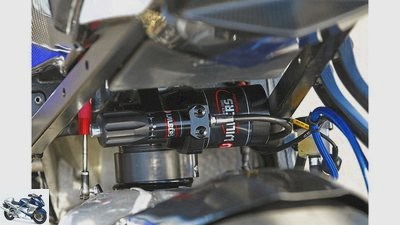
www.factstudio.de
20/27
Noticed: The team drives with a very tough chassis setup. All dampers are of course from Wilbers.
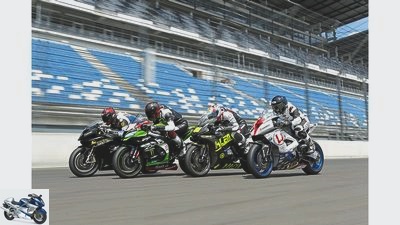
www.factstudio.de
21/27
Four furious four-cylinder units with different characteristics. What they have in common: all at lightning speed!
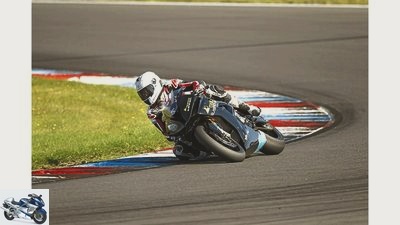
www.factstudio.de
22/27
Touratech BMW S 1000 RR. Lap time: 1.43.751 min.
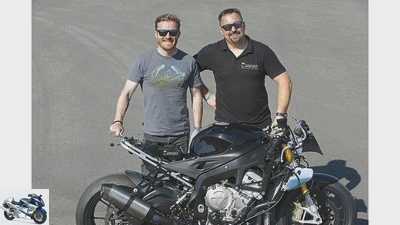
23/27
Touratech AG, Auf dem Zimmermann 7-9, 78078 Niedereschach. lars.wuerdemann@touratech.de
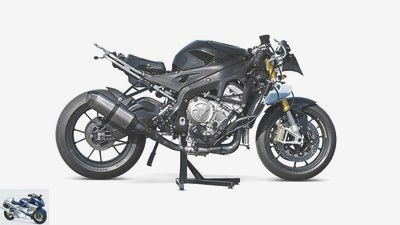
24/27
Weight 186.4 kg, front / rear 53.6 / 46.4%, output 208 hp, conversion costs approx. 9,000 euros.
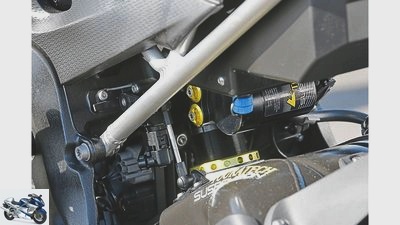
25/27
The high and low speed of the compression damping can also be adjusted mechanically on the shock absorber.
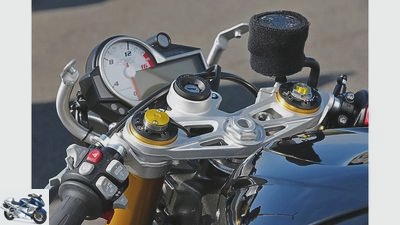
26/27
The Touratech chassis (36 mm cartridge at the front) works plug & play. As usual, the settings are made via the series cockpit.
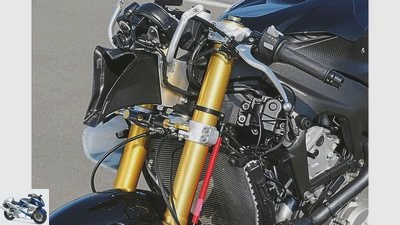
27/27
With the exception of the steering damper as part of the Touratech chassis, there is no further tuning under the accessory cover.
PS Bridgestone Tuner GP 2016 – 1000 Superbikes in comparison test
ZX-10R, YZF-R1 and S 1000 RR
Content of
Radical hardware changes, resourceful interventions in the electronics or skillful coordination work? It is the overall picture that makes a tuned superbike unique. At the PS Bridgestone TunerGP 2016, the four 1000 superbikes Bartschat-Kawasaki ZX-10R, Klein-Yamaha YZF-R1, Wilbers-BMW S 1000 RR and Touratech-BMW S 1000 RR faced each other.
First serve for the Kawasaki ZX-10R from BikeShop Luchow. In the Superbike World Championship, the Kawasaki works team rushes from victory to victory with the machine. A perfect image carrier – in theory. In practice, however, the bike is flat in the showrooms. There is a clear discrepancy between the actual potential of the ZX-10R and its power as a production bike. In previous PS comparison tests, the “Zehner” was able to set some accents, but the bottom line was that it was left behind compared to the competition. Main points of criticism: too tired in the middle speed range, handling not quite at the top level and the difficulties with the brake. Largely homemade problems that can be remedied with manageable effort, as Karsten and Ole Bartschat want to prove with their ZX-10R at TunerGP.
Buy complete article
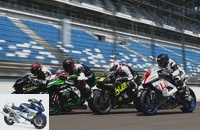
PS Bridgestone Tuner GP 2016 – 1000 Superbikes in comparison test
ZX-10R, YZF-R1 and S 1000 RR
Kawa stutters during the performance measurement
The first assessment after a session: The part is marching, and how! From the middle speed range the Kawasaki ZX-10R pushes with a force that is reminiscent of the torque of an electric motor. Concentration is required to keep the front wheel effectively on the ground. The Akrapovic complete system made of titanium and carbon makes only moderate noise, which increases the electric feeling together with the smooth running of the engine. A twist of the throttle, and suddenly the environment to the left and right of the track is blurred, as if you were sitting in a magnetic levitation train. During an endurance race, this meditatively calm vehicle behavior could be the key to success. A big praise goes to the blipper function of the automatic switch, which was also activated via the original control unit (costs 299 euros). The clutch-free gear changes go up and down super soft.
It’s reminiscent of Playstation gaming! Unfortunately, the throttle response is hard around 8000 rpm. The jolt can ruin the line quite a bit, although the ZX-10R with the mechanical Ohlins steering damper otherwise lies like a board. Karsten uses a laptop to smooth the throttle response in the relevant speed range. After that, the Kawa still doesn’t want to be really soft on the gas, even if it has gotten better. It feels like the Kawasaki ZX-10R should have at least 200 hp on the rear wheel, which our test bench does not confirm on site. A mistake has probably crept in when the wiring harness was cut to pick up the speed signal. The Kawa starts to stutter during the power measurement and delivers “only” 194 hp.
Please do the same in future in series production
Things are different on the slopes. “It seems brutally strong to me,” says PS racer Pascal Eckhardt. “In addition, the Kawasaki ZX-10R is incredibly stable on the brakes and then turns cleanly. You practically have a free choice of lines and you can drive really tight turns! ”You can tell that the tens is easy to handle after the first combination of curves. The Bartschat-Kawa turns it into child’s play where the production motorcycle could not be achieved at all on the targeted line. The sheer joy of how easy it is to fold down the machine and make corrections while cornering. And it is highly incomprehensible why Kawasaki is not launching the ZX-10R in the series in such a similar way.
In order to be able to use more spring travel, the Kawa received a fork conversion with a changed ratio of oil to air cushion and other shims. The original shock absorber flew out completely and was replaced by an Ohlins TTX-GP. In addition, the original brake pump was exchanged for a Brembo RCS 17, and Z04 racing brake pads from the same manufacturer were installed. This combination works excellently with the original M50 brake calipers, the Kawasaki ZX-10R decelerates fully and precisely. On the rear wheel, the ABS was deactivated using a dongle. However, it is active in the front. Heroic braking maneuvers with the rear wheel raised are permitted, the ABS does not appear negatively once. Our lap timesbolzer, ex-Moto2 rider Arne Tode, switches it off completely for his timed lap with a button on the handlebar. He has his principles there. For a lap around the Lausitzring he needs 1.43.569 minutes. A time that the ZX-10R from BikeShop Luchow honors.
Yamaha YZF-R1 from Dominik Klein
It continues with Dominik Klein’s Yamaha YZF-R1. He pursues a different philosophy with his project than the Bartschats with the long-distance kawa. The Yamaha should rock and get the (very) ambitious trackday hero really spectacular. Everything that is good and expensive is in here. The main thing is that it goes fast and bangs! Perhaps one or the other fan will remember the design – it is based on Rossi’s M1 from the winter tests in Sepang in 2007. The start number 41 belongs of course to Haga. It adorns all of Dominik’s bikes.
First of all, the two most important data: With a full tank, the Yamaha YZF-R1 weighs just 177.3 kilos – the record value of the PS-TunerGP 2016. Our test bench also attests a whopping 212 PS on the crankshaft and draws a performance curve as if drawn with a ruler . All fairing parts including Ram-Air made of carbon (Macmoto) contribute to the low overall weight of the machine. The original aluminum tank was brushed and sealed. The silver-matt OZ forged wheels are also a few grams lighter than the original ones and fit perfectly into the overall look.
“Take care, buddy, I’m poisonous”!
The starvation diet continues with ABS. Because it flew out. On the one hand, this is consistent (one less source of error) and, on the other hand, saves around five kilograms in weight. A lightweight LiFePo battery and endless titanium screws were also installed. The anorexia culminates in the complete titanium system from SC-Project. A special production by the Italian manufacturer, especially for Dominik’s Yamaha YZF-R1. It not only looks beautiful to kneel down and is obviously very well made. Due to the four manifolds, which converge in two further pipes directly at the rear silencer, the engine has more volume at the rear. Basic requirement for power with the R1 drive. Then the sound. The music to accompany the Horsemen of the Apocalypse must sound similar! The Big Banger thunders deeply and viciously, that stands out every Ducati. There is definitely a good deal of respect when you climb up. The clutch engages nastily when rolling off due to the synthetic linings (withstand more power). You have to concentrate a bit. Perhaps a kind of final warning that signals to the driver: “Take care, buddy, I’m poisonous”!
On the route, one aha-moment follows the next. You hold the front wheel of the Yamaha YZF-R1 practically directly in your hands. Everything is laser-like, precise and mercilessly direct. Perhaps with one exception: the response behavior of the four-cylinder engine is a bit blurred in the lower speed range, but the power then sets in gently. In addition, the R1 reacts cleanly and directly to every millimeter of more or less throttle position. There are no dents or dips in the power curve, but above 10,000 rpm, the bomb-proof mid-rev range is crowned with an extra boost. On the back straight of the Lausitzring, the small R1 is still doing power wheelies in fourth gear. My goodness, that part costs grains! It’s good that the built-in windshield (Ermax) offers fabulous wind protection. So you can breathe deeply for a few moments when the front wheel is back on the ground.
Similar to a Cup R6, but with a monstrous performance
The performance is no accident. At the beginning, the engine was completely dismantled, and Klein checked and optimized the bearing play and the connecting rods. Then the pinch edges were adjusted, channels and combustion chambers were machined and kit camshafts (different profiles and timing) were used. The kit camshafts with valve springs cost a mere 2000 euros and bring three horsepower. But if you want to be thorough, you also take that with you. Together with the SC-Project system, the funnel, which has been shortened in the lower area, continues to increase performance. A kit device from H2O Performance provides cooling. On the electronics side, Dominik Klein relies on the Yamaha kit wiring harness for his Yamaha YZF-R1, but uses the flashed series control unit.
This makes coordination more difficult, but it creates even more programming options due to the finer splitting of various parameters. For example, the traction control can be moved to intervene less than the default value “1”. The braking system sets the next high point. It is equipped with the Magura HC³ brake pump, the milled Brembo calipers GP4-RX (around 1500 euros!), T-Drive discs and Z04 pads. In terms of braking performance, the Kawasaki ZX-10R from BikeShop Luchow and the R1 are on a similar level. The high-end combination of parts of the Yamaha YZF-R1 would probably only prove to be more uniform or more stable in tough racing conditions.
What about the lap times??
There are two problems. First, the extreme wheelie tendency of the Yamaha YZF-R1 costs valuable seconds up to fourth gear. Second, when braking hard, the tail becomes light and the machine comes across quite a bit. The driving behavior is reminiscent of a sharp Cup R6. Only with monstrous performance! For Arne death’s timed lap, the wheelbase is slightly shortened, the gear ratio changed and a little more electronic engine brake applied via the dashboard so that the machine remains more controllable at the corner entrance. Like the shock absorber from K-Tech, the fork comes from England and is often used in road racing.
It gets a little less compression damping because Arne is too progressive and hard when it is immersed below. Dominik takes some preload out of the shock absorber. The bike is now lower at the back so that the tire can better mesh with the slope. After a few laps, the clock shows 1.42.380 minutes, and a satisfied Arne Tode returns to the pits. The wheeli tendency of the Yamaha YZF-R1 has completely disappeared and extreme sliding has been stopped. Arne sums it up: “The bike is pure emotion, there is really the spirit of the tuner in it. If I had too much money now, I would invite the item immediately. ”There is nothing more to add.
Wilbers’ BMW S 1000 RR starts in the IDM Superbike
If there is so much on offer for the “hobby pilot” as seen and experienced with the Kawasaki-ZX-10R and Yamaha YZF-R1, what does professional racing have in store for aces? The BMW S 1000 RR from Wilbers Triple Tuning GmbH provides the answer. The team rides in the IDM Superbike with Belgian rider Bastien Mackels. Our test bench certifies its RR 217 hp, the scale shows 179.9 kilos with a full tank. Most racing machines are less about what is technically possible. Rather, it is about what the regulations allow. In the IDM Superbike, no bike can be lighter than 168 kilos (dry). The Wilbers-BMW is just below that, so the team works with additional weights that are distributed as cheaply as possible. Only camshafts, valve timing and compression are made in the engine – nothing more may be changed mechanically.
The key to success is therefore drivability, which requires perfect coordination including the electronics. And indeed, the BMW S 1000 RR behaves outside on the track as if it was only built for the Lausitzring. The HP-Race-Motorsport-Electronics in connection with the HP-Race-Calibration-Kit 3 Pro makes it possible. The mapping and the intervention of traction control and electronic engine braking change noticeably for each bend. Handling, stability, braking and turning behavior – everything at its finest. The motorcycle accelerates as smoothly as butter, then converts every crankshaft revolution into efficient, clinically pure propulsion. The BMW is reminiscent of a magnetic train, similar to the Kawasaki ZX-10R. Then this surgically precise gear. Quickshifter and Blipper couldn’t work better. “We have only reached this level of drivability now, after six years of experience with the machine,” says technical director Burkhard Stember, explaining the fine-tuning of the BMW.
According to Arne Tode, there are two types of drivers
The damping of the chassis is brutally tight (completely Wilbers), which for some testers precisely results from this precision. Burkhard Stember says that the setup tends to be even tighter in races. Because the bike has to be crisp enough to be able to turn over quickly. At the same time, it has to take along all the waves in the asphalt in order to get the maximum grip. The following assessment of the chassis is interesting. Stember: “We have so much experience with the HP4 from 2013 and 2014 that we would prefer to use the electronic rather than the conventional chassis if possible. Unfortunately, this is no longer technically possible. The communication system has changed from CAN bus to LIN bus between the model years. BMW is currently unable to supply the corresponding control unit that we need. “
According to Arne Tode, there are two types of drivers. Some prefer softer chassis that work harder. Others get along better with stiffer chassis. He himself is a fan of the softer variant. His time with the Wilbers-BMW S 1000 RR: 1.42.780 min. PS tester Rene Raub, on the other hand, gets off the RR and says in his sober and matter-of-fact manner: “I think this is the best motorcycle I’ve ever ridden.” Rene seems to be a tough guy.
Curtain up for the BMW S 1000 RR from Touratech
Curtain up for the fantastic number four in the league. Again it is a BMW S 1000 RR and it comes with a semi-active suspension from Touratech. You read that right! The well-known travel accessories and conversion specialist meanwhile offers suspension systems for super athletes with the “Competition Line”. The semi-active system is currently only available for BMWs that are factory-fitted with DDC. However, it is in preparation for other brands and models. The Touratech chassis (€ 3398 in total) can be “plugged” on the S 1000 RR & play ”(cartridge unit at the front) and can be operated normally via the dashboard. The advantage of the system developed by Touratech in collaboration with Tractive: The solenoid valves open and close three times faster than the valves from Sachs / ZF (DDC from BMW). The compression damping on the shock absorber (high and low speed) can also be set mechanically. The semi-active chassis from BMW reaches its limits at some point, that of Touratech not, that is the promise.
The test and development work was largely carried out under ex-IDM racer Stefan Nebel. Stefan: “We grabbed a standard BMW S 1000 RR and thought about what useful changes we could make to make a fast motorcycle for the hobby racer.” Besides the Touratech Competition Line suspension, the BMW only wears a racing fairing, a Remus -Complete system and a footrest system from TRW. For this purpose, Motomaster brake discs, Lucas brake pads and an HP Race Calibration Kit 3 are installed. We said goodbye to ABS. There are no technical changes to the engine, but with 208 hp the drive is well placed in the forage.
Chassis forgives the undulating surface in curves well
First field trial. The high braking stability of the Touratech BMW S 1000 RR is fantastic. You can hit the brakes like the devil. Then you notice how the compression damping closes. After releasing the brake, the damping changes and the motorcycle can be folded down sharply immediately. “We try to keep the driving experience as close as possible to a conventional chassis,” explains Lars Wurdemann, Head of Business at Touratech who is responsible for the chassis. That seems to have worked out quite well so far!
When accelerating out, the rear with the BMW DDC occasionally began to pump. With the Touratech chassis, the hindquarters remain calm despite full throttle; no pumping can be observed. Sensitive people feel a slight restlessness in the handlebars, which may be due to the respective driving style. The horsepower racing drivers Arne and Ecke agree: “Great drivability, great balance. That fits! ”Rene Raub says appreciatively:“ The suspension of the Touratech BMW S 1000 RR forgives the undulating surface in corners really well. In terms of handling, I like the motorcycle almost as much as a 600. ”There is definitely a lot going for a near-series BMW S 1000 RR, as Arne Tode proves with a lap time of 1.43.751 minutes. When development driver Stefan Nebel pulls on the cable of his BMW himself, there is even a 1.42.155 on the clock. For 99 percent of all hobby drivers, Arne’s time should be enough as a yardstick. No matter with which motorcycle and however tuned.
The lap times
Bartschat-Kawasaki ZX-10R: 1.43,569 min
Small Yamaha YZF-R1: 1.42.380 min
Wilbers-BMW S 1000 RR: 1.42.780 min
Touratech BMW S 1000 RR: 1.43.751 min
Related articles
-
Comparison test of superbikes, part 1: Country road
Jorg Kunstle 36 pictures 1/36 Comparison test Superbikes: Aprilia RSV4 RF, BMW S 1000 RR, Kawasaki ZX-10R, Yamaha YZF-R1M. 2/36 …
-
Comparison test BMW S 1000 RR, Kawasaki ZX-10R and Yamaha YZF-R1M
22 images 1/22 BMW S 1000 RR, Kawasaki Ninja ZX-10R and Yamaha YZF-R1M. 2/22 Yamaha YZF-R1M. 3/22 BMW …
-
Comparison test Kawasaki GTR 1000, Triumph Trophy 1200, Yamaha FJR 1300
fact comparison test Kawasaki GTR 1000, Triumph Trophy 1200, Yamaha FJR 1300 As time goes by In honor grayed out ?? and still to have: two veteran …
-
Comparison test: Honda CB 1000 R, Yamaha FZ1, Triumph Speed Triple, Kawasaki Z 1000
Comparison test: Honda CB 1000 R, Yamaha FZ1, Triumph Speed Triple, Kawasaki Z 1000 Large naked bikes in comparison Contents of …
-
Comparison test of the 1000 super sports car in 2006
fact comparison test of the 1000 super sports car 2006 The show must go on The mystery repeats itself. Whenever we think that there is nothing more …
-
Comparison test of superbikes part 2 – racetrack
51 pictures 1/51 The Kawa brake was transformed. She looked dull and lacked exact feedback. …
-
Comparison test of the 1000 super sports car
Jaime de Diego 38 pictures fact 1/38 Yamaha demands 14895 euros for their completely new R1 super sports car. fact 2/38 Even without ABS, the Fireblade would …
-
Comparison test of the 1000 super sports car, part 1
Jahn comparison test 1000 super sports car, part 1 The full range Slim, strong, ready to attack, with the Suzuki GSX-R 1000 is the field of …
-
Comparison test 750 superbikes
Comparison test of 750cc superbikes The latest rumor that Suzuki had built a divine bike with the super light GSX-R, Kawasaki’s brand new ZX-7R was a …
-
Comparison test of supersports: Honda CBR 600 F, Kawasaki ZX-6R, Suzuki GSX-R 600, Yamaha YZF 600 R
Comparison test of super sports cars: Honda CBR 600 F, Kawasaki ZX-6R, Suzuki GSX-R 600, Yamaha YZF 600 R Let’s twist again Wake up, people. In the 600s …